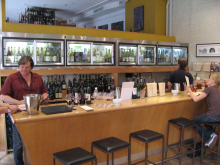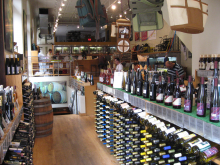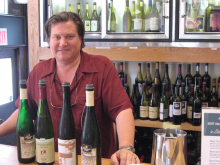I have tasted some very interesting and distinctive wines from New York over the years, and have always wanted to get a much more comprehensive sense of what winemakers across that state are achieving. But I knew of no easy way to do this. Until now.
I live in the Washington, D.C. metro area, which is a terrific wine market, but consumers here have virtually no shot at wines from New York state. Something like 95% of the bottles from New York that I've seen here since the late 1980s were made by Bully Hill Vineyards. Stores seemed to stock them not on grounds of quality but because they could be sold to nostalgic New York expatriates who were pining for home (and we've got loads of these around here).
My guess is that you confront the same situation if you live in Philadelphia or Cleveland, much less in Dallas or Albuquerque. It doesn't seem right that we can easily acquire a Pinot Noir from New Zealand or a Pinotage from South Africa, but can't get our hands on a bottle from a state with more than 200 wineries. For most of us, however, that is just the way it is.
Having tasted some killer Rieslings from the Finger Lakes and some very convincing reds from Long Island, I was not happy about this situation, but I was resigned to it--until an interesting window of opportunity opened earlier this summer. At dinner in Manhattan, an acquaintance told me about a couple of wine shops in the city that specialized in New York wines and had the capability to show them in impressive numbers at a tasting bar in the store. My friend explained that his brother runs these places, and that we could tear through a whole bunch of wines during my next visit to the city.
That was all I needed to hear. When I was back in Manhattan  last month, I spent a little more than an hour tasting with my friend David Ransom and his brother, Robert, at the Vintage New York store in SoHo. And I must say, this was probably the most illuminating hour of wine tasting that I've enjoyed in 2007 (and that includes a lot of hours spent tasting in a lot of different countries!).
last month, I spent a little more than an hour tasting with my friend David Ransom and his brother, Robert, at the Vintage New York store in SoHo. And I must say, this was probably the most illuminating hour of wine tasting that I've enjoyed in 2007 (and that includes a lot of hours spent tasting in a lot of different countries!).
There are actually three locations for Vintage New York, which should offer many of you who travel to New York the same  opportunity that I enjoyed. The location I visited is at 482 Broome Street, and includes a large, attractive wine shop, a tasting bar with over 200 wines offered by the glass, and a kitchen serving 56 dining seats on two levels. There's a second VNY in Manhattan at 2492 Broadway (at 93rd Street), as well as a third at Rivendell Winery in the Hudson Valley. Rivendell is a very serious winery with many awards to its credit, and it too is owned by the Ransoms, who seem to have something of a New York wine empire on their hands. You can find all the particulars on these places at a single website, www.vintagenewyork.com
opportunity that I enjoyed. The location I visited is at 482 Broome Street, and includes a large, attractive wine shop, a tasting bar with over 200 wines offered by the glass, and a kitchen serving 56 dining seats on two levels. There's a second VNY in Manhattan at 2492 Broadway (at 93rd Street), as well as a third at Rivendell Winery in the Hudson Valley. Rivendell is a very serious winery with many awards to its credit, and it too is owned by the Ransoms, who seem to have something of a New York wine empire on their hands. You can find all the particulars on these places at a single website, www.vintagenewyork.com
Obviously, I make no claims to expertise regarding New York wines on the basis of my hour of tasting, though I did learn a great deal regarding the history and viticultural conditions of the state during that hour. Several of my Wine Review Online colleagues are certainly much more thoroughly experienced than I am, including Michael Apstein, Mary Ewing-Mulligan, Paul Lukacs, Ed McCarthy and Marguerite Thomas, and perhaps others as well.
Accordingly, I will not offer an overview of growing conditions or of the wine trade in New York, which I couldn't really accomplish within the confines of a brief column in any case. What seems better to me is to offer some tasting notes on the most striking wines that I encountered, as these should offer you all the motivation you'll need to do some learning and tasting for yourself--which is always my objective when writing about wine.
Although I make no claims regarding expertise on New York wines, I'm entirely prepared to claim complete objectivity in evaluating them. I don't know any New York vintners personally, and have never lived in the state, have no reason aside from the merits or demerits of the wines to either like or dislike the fruits of the New York industry's labor.
When judging wine competitions, I've encountered a fair number of experienced tasters who live in the eastern U.S. who show what I believe is an inappropriate favoritism for eastern wines. They often forgive characteristics that I am not prepared to forgive on the dubious ground of being "typical" for the region or "true to the local terroir."
I want to be very clear on this: Lots of eastern wines are horrible, and lots of these are bad not because they were botched along the way, but because the grapes were grown in places that routinely make nasty, bizarre, and often undrinkable wine. For example, plenty of reds from central Virginia have an aromatic note that is strikingly reminiscent of rubber boots. Nobody is going to succeed in convincing me that this should be forgiven on account of being "typical" for the region. On the contrary, I figure that vintners in the area had better do one of two things: Get that note out of their wines, if they can, or get themselves out of the winemaking business.
So, all of the reviews below were written in a coldly objective vein, considering the wines in a global context and scoring them accordingly.
A quick sensory overview may be helpful as a point of departure. New York's growing regions are certainly on the cooler side of the norm for viticulture in the United States, and this is quite apparent when tasting a broad cross section of the state's wines. The Rieslings from the Finger Lakes are wonderfully lean and elegant, though not austere. Other whites show restrained ripeness and moderate weight, and both of these are characteristics that suit my personal preferences.
The same goes for the reds, and the preponderance of Cabernet Franc and Merlot in what I tasted suggests that earlier-ripening varieties probably do better in New York in most years than Cabernet Sauvignon. The reds were generally medium-bodied, with fruit that wasn't green or under-ripe, but that likewise wasn't overtly ripe or juicy. Consequently, the wines are delightfully hard to peg: Cabernet Francs seem riper than their counterparts from France's Loire Valley, but certainly not as ripe as comparable wines from California or Washington. Their weight and restraint make the best reds seem extremely promising as partners for food, and likewise I suspect that they can show some interesting secondary aromas if permitted a few years of bottle age.
One last caveat: I'm sure that the following notes represent the  cream of New York's crop, and that one can expect to take a step or two down when stepping beyond wines like these. Robert Ransom seemed like a smart guy and a good taster, and it would not have been in his interest to show me a bunch of dogs when running me through this tasting. But with that said, I remain very impressed with what New York can achieve at its best, and delighted to pass along the news that there's a place where you can very efficiently taste your way through some of the most exciting wines made in North America.
cream of New York's crop, and that one can expect to take a step or two down when stepping beyond wines like these. Robert Ransom seemed like a smart guy and a good taster, and it would not have been in his interest to show me a bunch of dogs when running me through this tasting. But with that said, I remain very impressed with what New York can achieve at its best, and delighted to pass along the news that there's a place where you can very efficiently taste your way through some of the most exciting wines made in North America.
Dr. Konstantin Frank, Finger Lakes (New York) Dry Riesling 2006 ($24): This undeniably excellent wine shows perfect integration of fruit and acidity. The depth of flavor is very impressive, with fruit recalling green apples and some citrus around the edges. The texture of the wine is also quite impressive, with an element of richness but also an excellent linear component that is rooted in the wine's bright acidity. 90
2006 ($24): This undeniably excellent wine shows perfect integration of fruit and acidity. The depth of flavor is very impressive, with fruit recalling green apples and some citrus around the edges. The texture of the wine is also quite impressive, with an element of richness but also an excellent linear component that is rooted in the wine's bright acidity. 90
Hermann J. Wiemer, Finger Lakes (New York) Dry Riesling 2006 ($24): This is notably sweet despite the label's claim to a dry style. Nevertheless, the fruit is certainly delicious and even a bit exotic, with notes of papayas and baked apples. Softly rounded in texture, this is still bright and balanced thanks to zesty acidity. 89
 Rivendell, Finger Lakes (New York) Dry Riesling 2006 ($19): This wine offers lots of fruit flavor without a lot of overt sweetness, which is impressive. Notes of apples and citrus fruit are very expressive, offering real intensity and length in the finish. The acidity is excellent. 88
Rivendell, Finger Lakes (New York) Dry Riesling 2006 ($19): This wine offers lots of fruit flavor without a lot of overt sweetness, which is impressive. Notes of apples and citrus fruit are very expressive, offering real intensity and length in the finish. The acidity is excellent. 88
Dr. Konstantin Frank, Finger Lakes (New York) Rkatsiteli 2006 ($25): Frank's rendition of this variety from Georgia is very expressive and interesting, with lovely floral aromas and tropical fruit notes. It tastes a bit like a cross between Riesling and a very good Pinot Blanc. Fruit and acidity are very well integrated. 88
Lamoreaux Landing, Finger Lakes (New York) Dry Riesling 2006 ($17): An interesting wine showing subtle fruit but some very appealing notes that are slightly earthy. Soft in texture, this doesn't show particularly intense acidity or much spritziness, but the aromatic complexities are very nice. 87
Millbrook, Hudson Valley (New York) Tocai Friuliano 2005 ($18): Showing nice roundness and quite generous fruit, this offers vivid flavors that benefit from a faintly bitter note in the finish. 87
Hunt Country Vineyards, Finger Lakes (New York) Pinot Gris 2006 ($16): This wine is clearly made from fine fruit, as the notes of ripe apples and poached pears are quite pure and expressive. It shows a nice rounded profile, but is also adequate in acidity, and it finishes cleanly. 87
Palmer Vineyards, North Fork (Long Island, New York) Pinot Blanc 2005 ($16): Although this wine is not as famous as the Pinot Blanc made in the same region by Leib Family Cellars, I though it was far superior. It features subtle fruit that recalls apple and pear, with excellent acidity. The integration of fruit and acidity is excellent. 86
SoHo Cellars, Finger Lakes (New York) Johannesburg  Riesling 2006 ($17): This wine isn't at the top of the heap in terms of elegance or reserve, but it more than makes up for this in terms of gushy expressiveness. Notes of mandarin orange and baked apple are juicy and delicious. 86
Riesling 2006 ($17): This wine isn't at the top of the heap in terms of elegance or reserve, but it more than makes up for this in terms of gushy expressiveness. Notes of mandarin orange and baked apple are juicy and delicious. 86
Pellegrini Vineyards, North Fork (Long Island, New York) 'Encore' 2001 ($42): This terrific blend shows superb aromatic complexity, along with excellent depth of flavor and persistence in the finish. At this age, it shows both primary fruit notes (both red and black fruits are in evidence) as well as some interesting secondary notes recalling tobacco leaf and wild mushrooms. Soft but still notably fresh, with no hint of over-extraction, this is a completely convincing, thoroughly impressive wine. 91
Bedell, North Fork (Long Island, New York) Merlot Reserve 2005 ($50): No one could doubt that this is a world-class wine, and it probably doesn't hurt that Paul Pontallier of Chateau Margaux makes four consulting visits to this producer each year. The fruit shows delicious plum and black cherry notes, and the tannins are abundant but very fine in grain. Wood notes are notable but precisely balanced against the wine's fruit, and the finish is long and symmetrical. Fantastic! 90
2005 ($50): No one could doubt that this is a world-class wine, and it probably doesn't hurt that Paul Pontallier of Chateau Margaux makes four consulting visits to this producer each year. The fruit shows delicious plum and black cherry notes, and the tannins are abundant but very fine in grain. Wood notes are notable but precisely balanced against the wine's fruit, and the finish is long and symmetrical. Fantastic! 90
 Red Newt Cellars, Finger Lakes (New York) Cabernet Franc Reserve 2005 ($40): Great Cab Franc from the Finger Lakes…who knew? Not me before tasting this wine, but I found it entirely convincing, and actually well worth the hefty price tag. Deep and dark, it displays blackberry fruit with a black cherry note as well, and the wood and tannin are nicely weighted in balance with the fruit. A light herbal aroma is true to the grape variety, and is quite pleasant without seeming green or under-ripe. 90
Red Newt Cellars, Finger Lakes (New York) Cabernet Franc Reserve 2005 ($40): Great Cab Franc from the Finger Lakes…who knew? Not me before tasting this wine, but I found it entirely convincing, and actually well worth the hefty price tag. Deep and dark, it displays blackberry fruit with a black cherry note as well, and the wood and tannin are nicely weighted in balance with the fruit. A light herbal aroma is true to the grape variety, and is quite pleasant without seeming green or under-ripe. 90
Wölffer Estate, Hamptons (Long Island, New York) Merlot Estate Selection 2002 ($40): A beautiful wine that shows exceptionally skillful winemaking, this is very polished, but not overly domesticated. Sweet and soft, with lovely texture, it gets very close to being too pretty, but stays on the right side of that line. 89
Corey Creek, North Fork (Long Island, New York) Cabernet Franc 2005 ($30): Fruit notes reminiscent of red and black cherries as well as plums are very tasty and pure, and though there is a lot of wood influence showing in the form of spicy, smoky accents, this is well balanced. 88
 Lenz, North Fork (Long Island, New York) Merlot Old Vines 2001 ($60): Deeply flavorful, with good intensity that is achieved without a lot of body or weight. Red and black berry notes are very pleasant, and tannin and wood are nicely balanced. 88
Lenz, North Fork (Long Island, New York) Merlot Old Vines 2001 ($60): Deeply flavorful, with good intensity that is achieved without a lot of body or weight. Red and black berry notes are very pleasant, and tannin and wood are nicely balanced. 88
Pellegrini Vineyards, North Fork (Long Island, New York) Cabernet Franc 2002 ($21): An exotic, earthy wine, this shows some secondary notes from age but also some rather funky fruit notes that I thoroughly enjoyed. There's still some primary fruit notes in evidence, but the faintly earthy accent aromas still steal the limelight. 87